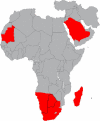Rift valley fever: recent insights into pathogenesis and prevention
- PMID: 21450816
- PMCID: PMC3126526
- DOI: 10.1128/JVI.02641-10
Rift valley fever: recent insights into pathogenesis and prevention
Abstract
Rift Valley fever virus (RVFV) is a zoonotic pathogen that primarily affects ruminants but can also be lethal in humans. A negative-stranded RNA virus of the family Bunyaviridae, this pathogen is transmitted mainly via mosquito vectors. RVFV has shown the ability to inflict significant damage to livestock and is also a threat to public health. While outbreaks have traditionally occurred in sub-Saharan Africa, recent outbreaks in the Middle East have raised awareness of the potential of this virus to spread to Europe, Asia, and the Americas. Although the virus was initially characterized almost 80 years ago, the only vaccine approved for widespread veterinary use is an attenuated strain that has been associated with significant pathogenic side effects. However, increased understanding of the molecular biology of the virus over the last few years has led to recent advances in vaccine design and has enabled the development of more-potent prophylactic measures to combat infection. In this review, we discuss several aspects of RVFV, with particular emphasis on the molecular components of the virus and their respective roles in pathogenesis and an overview of current vaccine candidates. Progress in understanding the epidemiology of Rift Valley fever has also enabled prediction of potential outbreaks well in advance, thus providing another tool to combat the physical and economic impact of this disease.
Figures


References
-
- Abdo-Salem S., et al. 2011. Risk assessment of the introduction of Rift Valley fever from the Horn of Africa to Yemen via legal trade of small ruminants. Trop. Anim. Health Prod. 43:471–480 - PubMed
-
- Adam A. A., Karsany M. S., Adam I. 2010. Manifestations of severe Rift Valley fever in Sudan. Int. J. Infect. Dis. 14:e179–e180 - PubMed
-
- Balkhy H. H., Memish Z. A. 2003. Rift Valley fever: an uninvited zoonosis in the Arabian peninsula. Int. J. Antimicrob. Agents 21:153–157 - PubMed
-
- Bengis R. G., Swanepoel R., De Klerk M., Pienaar N. J., Prinsloo G. 2010. Rift Valley fever: current concepts and recent findings, p. 12–14 In Proceedings of the 9th Annual Congress of the South African Society for Veterinary Epidemiology and Preventive Medicine South African Society for Veterinary Epidemiology and Preventive Medicine, Pretoria, Republic of South Africa
Publication types
MeSH terms
Substances
LinkOut - more resources
Full Text Sources
Other Literature Sources

